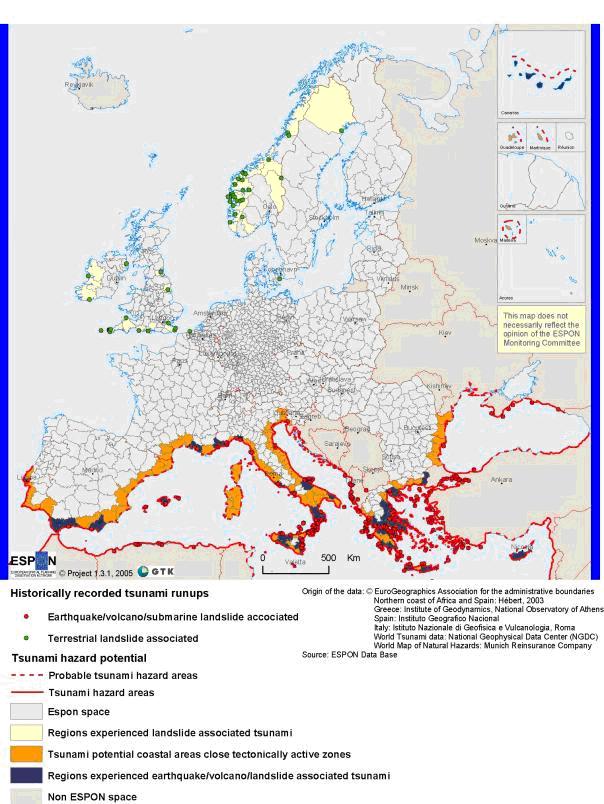Risques Naturels
Tsunami
Préparé par le CERG – European Centre on Geomorphological Hazards – Strasbourg, France & the Editorial Board

Un tsunami (mot japonais qui signifie « vague portuaire ») est une des forces de la nature les plus terrifiantes. Sous l’effet d’une force d’impulsion qui s’exerce dans l’océan, une masse d’eau se met en mouvement, créant une série de vagues caractérisées par une longueur d’onde extrêmement importante et une période longue.
Un tsunami est composé de 5 à 6 vagues dont la première est appelée petite vague. La deuxième et la troisième vagues sont de très grosses vagues qui causent d’énormes dégâts.
Pour plus d’informations sur les Tsunamis, cliquez ICI
Un tsunami (mot japonais qui signifie « vague portuaire ») est une des forces de la nature les plus terrifiantes. Sous l’effet d’une force d’impulsion qui s’exerce dans l’océan, une masse d’eau se met en mouvement, créant une série de vagues caractérisées par une longueur d’onde extrêmement importante et une période longue. Le tsunami est composé de 5 à 6 vagues dont la première est appelée petite vague. La deuxième et la troisième vagues sont de très grosses vagues qui causent d’énormes dégâts.
En mer, la hauteur des vagues d’un tsunami est inférieure à 60 cm et n’est pas visible d’un aéronef ou d’un navire. En revanche, leur longueur, qui dépasse souvent 160 km, est bien supérieure à la profondeur de l’eau sur lequel elles se déplacent. Le tableau 1 compare les caractéristiques respectives des vagues de vent et des vagues de tsunami. Lorsque la profondeur de l’océan est supérieure à 6 000 mètres, les vagues de tsunami, à peine visibles, atteignent la vitesse d’un avion commercial, soit plus de 800 km par heure. Elles peuvent se déplacer d’une rive de l’océan Pacifique à l’autre en moins d’une journée. Il est donc très important de repérer le tsunami dès son origine. Les tsunamis se déplacent beaucoup moins rapidement dans les eaux littorales moins profondes, où leurs vagues commencent à grossir d’une manière spectaculaire.
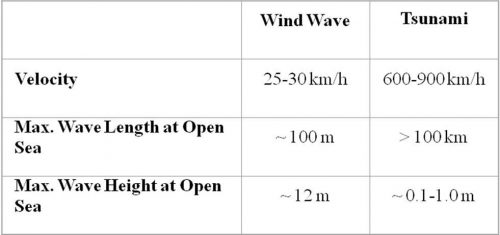
Generation of Tsunamis
Once the event which initiates the tsunami occurs the potential energy that results from pushing water above mean sea level is then transferred to horizontal propagation of the tsunami wave (kinetic energy). The return of the sea level to its normal position generates a series of waves propagating in all directions from the initially deformed area.
Propagation of Tsunamis The speed at which the tsunami travels depends on the water depth. If the water depth decreases, tsunami speed decreases. In the mid-Pacific, where the water depths reach 4.5 kilometers, tsunami speeds can be more than 900 kilometers per hour. Refraction and diffraction of waves are important to the tsunami propagation.
Refraction Consider progressive waves with wavelengths much larger than the water depths over which they propagate. These are called shallowwater or long waves. Because the waves are long, different parts of the wave might be over widely varying depths (especially in coastal areas) at a given instant. As depth determines the velocity of long waves, different parts travel with different velocities, causing the waves to bend, and this is called wave refraction. (Shallower the water depth, less is the velocity.)
Diffraction Diffraction can be considered as the bending of waves around objects. It is this kind of movement that allows waves to move past barriers into harbors as energy moves laterally along the crest of the wave. Offshore and coastal features can therefore determine the size and impact of tsunami waves. Reefs, bays, entrances to rivers, undersea features and the slope of the beach all help to modify the tsunami as it attacks the coastline. When the tsunami reaches the coast and moves inland, the water level can rise many meters. In extreme cases, water level has risen to more than 15 m for tsunamis of distant origin and over 30 m for tsunami waves generated near the earthquake’s epicenter. Since the first wave may not be the largest in the series of waves, one coastal community may see no damaging wave activity while in another nearby community destructive waves can be large and violent. The flooding can extend inland by 300 m or more, covering large expanses of land with water and debris.
Il n’existe pas un seul type de tsunami, car chaque tsunami est différent, mais ils ont tous une caractéristique commune : ils contiennent une quantité d’énergie phénoménale, ce qui les rend uniques, même si on les compare aux vents de vague les plus puissantes.
Les tsunamis peuvent être classés cependant par selon les mécanismes de leur création: tsunamis créés par un séisme, une éruption volcanique, un glissement de terrain et un impact (un astéroïde par exemple). On distingue également, selon l’éloignement des côtes du phénomène déclencheur et son emplacement, les tsunamis créés à distance et les tsunamis locaux.
When a tsunami travels a long distance across the ocean, the sphericity of the Earth must be considered to determine the effects of the tsunami on a distant shoreline. Waves which diverge near their source will converge again at a point on the opposite side of the ocean. An example of this was the 1960 tsunami whose source was on the Chilean coastline, 39.5S., 74.5 W. The coast of japan lies between 30 and 45N. and about 135 to 140 E., a difference of 145 to 150 longitude from the source area. As a result of the convergence of unrefracted wave rays, the coast of japan suffered substantial damage and many deaths occurred.
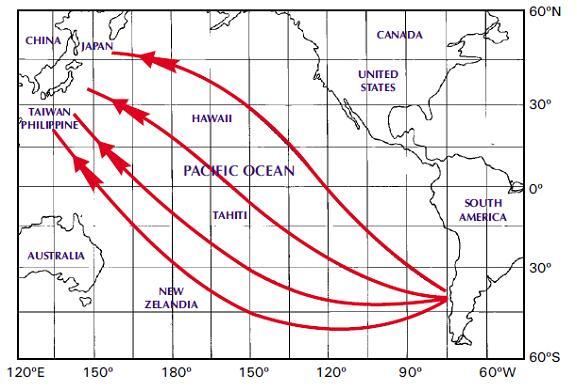
As a tsunami approaches a coastline, the waves are modified by the various offshore and coastal features. Submerged ridges and reefs, the continental shelf, headlands, the shapes of bays, and the steepness of the beach slope may modify the wave height, cause wave resonance, reflect wave energy, and/or cause the waves to form bores which surge onto the shoreline.
Ocean ridges provide very little protection to a coastline. While some amount of the energy in a tsunami might reflect from the ridge, the major part of the energy will be transmitted across the ridge and onto the coastline. The 1960 tsunami which orignated along the coast of Chile is an example of this. That tsunami had large wave heights along the entire coast of Japan, including the islands of Shikoku and Kyushu which lie behind the South Honshu Ridge.
Locally generated Tsunamis
When a locally generated tsunami occurs, it impacts coastal areas a very short time after the event which produced the tsunami (earthquake, submarine volcanic eruption or landslide). Lapses as short as two minutes have been observed between the earthquake’s occurrence and the tsunami arrival to the closest shore. Because of this, a tsunami warning system is useless in this type of event and we should not expect instructions from an established system to react and keep us safe from the possible tsunami impact. This operation incapability of the warning systems is further increased by the communications and systems collapse generated by the earthquake. Hence, it is necessary to prepared in advance a proper response plan in case of a tsunami.
L’impulsion qui est à l’origine des tsunamis peut être provoquée par un glissement de terrain, une éruption volcanique et un impact d’objet extra-terrestre (météorites, astéroïdes et comètes), mais ils sont la plupart du temps déclenchés par des séismes sous-marins.
Création d’un tsunami
Dès que le phénomène mécanique qui déclenche le tsunami se produit, l’énergie potentielle qui résulte de la poussée de l’eau au-dessus du niveau moyen de la mer se transforme en propagation horizontale de la vague de tsunami (énergie cinétique). Le retour du niveau de la mer à sa position normale crée une série de vagues qui se propage dans toutes les directions à partir de la zone initialement déformée (Figure 1).
Propagation d’un tsunami
La vitesse à laquelle se déplace un tsunami dépend de la profondeur de l’eau. Si celle-ci diminue, la vitesse du tsunami augmente. Au milieu du Pacifique, où les profondeurs atteignent 4,5 km, la vitesse d’un tsunami peut dépasser 900 kilomètres par heure. La réfraction et la diffraction des vagues sont importantes pour la propagation du tsunami.
TSUNAMI DÉCLENCHÉ PAR UN SÉISME
Les tsunamis déclenchés par un séisme se produisent lorsque le fond de la mer déforme ou déplace brutalement la couche d’eau qui le recouvre de sa position d’équilibre (Figure 1). Cependant, tous les séismes ne produisent pas de tsunamis. Pour déclencher un tsunami, la faille où le séisme se produit doit être sous l’océan, ou proche de celui-ci, et créer un mouvement vertical du fonds marin (jusqu’à plusieurs mètres) sur une zone importante (jusqu’à cent mille kilomètres carrés). Les séismes qui se produisent à faible profondeur (moins de 70 km) le long des zones de subduction (où une plaque océanique glisse sous une plaque continentale ou une autre plaque océanique plus jeune) sont responsables des tsunamis les plus destructeurs.
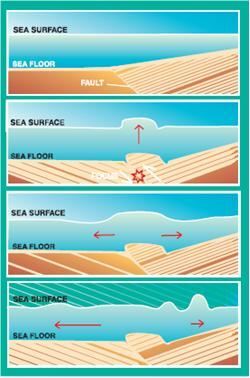
TSUNAMI DÉCLENCHÉ PAR UN GLISSEMENT DE TERRAIN
Les glissements de terrain (sous-marins et subaériens), qui se produisent souvent pendant un séisme d’envergure, peuvent aussi créer un tsunami. Pendant un glissement de terrain sous-marin, l’équilibre du niveau de la mer est modifié par les sédiments qui se déplacent sur le fond de la mer.
TSUNAMI DÉCLENCHÉ PAR UNE ÉRUPTION VOLCANIQUE
Une éruption volcanique marine violente peut aussi créer une force d’impulsion qui déplace la colonne d’eau et déclenche un tsunami.
TSUNAMIS DÉCLENCHÉ PAR UN IMPACT
Fort heureusement, il est rare qu’un météorite ou un astéroïde s’écrase sur la terre. À ce jour, aucune archive humaine ne fait état d’un tsunami qui aurait été déclenché par un météorite ou un astéroïde. Il existe cependant des preuves de la chute de météorites et d’astéroïdes sur notre planète. Certains ont terminé leur course dans l’océan ou la mer, car notre planète est recouverte au quatre cinquième d’eau. Leur chute dans l’océan peut déclencher des tsunamis ayant des conséquences cataclysmiques.
One of the most destructive tsunamis in recent history was generated along Chile’s coast by an earthquake in May 22, 1960 (Figure 2). Every coastal town between latitudes 36S and 44S was destroyed or severely damaged by the action of the tsunami and the earthquake. In Chile, the double combination of earthquake and tsunami produced more than 2,000 deaths, 3,000 injured, two million homeless, and damage worth $550 million (US). The tsunami caused 61 deaths in Hawaii, 20 in the Philippines, 3 in Okinawa, and more than 100 in Japan. The height of the waves ranged from 13 meters at Pitcairn Islands, 12 meters at Hilo, Hawaii, and 7 meters at several places in Japan, to minor oscillations in other areas.

One of the most interesting landslide generated tsunamis happened in 1958 where about 81 million tones of ice and rock crashed into Lituya Bay, Alaska, Fifuren3). An earthquake had shaken the enormous mass loose. The landslide created a tsunami which sped across the bay. Waves splashed up to an astonishing height of 350 to 500 metres – the highest waves ever recorded. They scrubbed the mountain slope clean of all trees and shrubs. Miraculously, only two fishermen were killed.
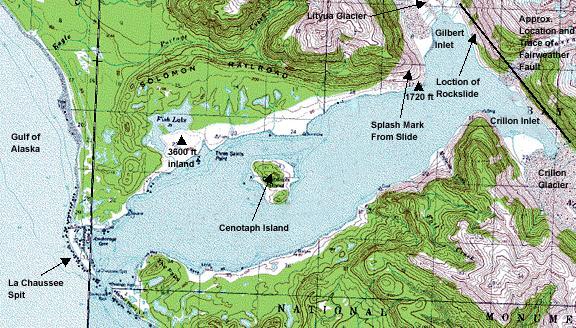
In 1883, a series of volcanic eruptions at Krakatau in Indonesia created a powerful tsunami. As it rushed towards the islands of Java and Sumatra, it sank more than 5,000 boats and washed away many small islands. Waves as high as a 12-story buildings wiped out nearly 300 villages and killed more than 36,000 people. Scientist believe that the seismic waves traveled two or three times around the Earth.
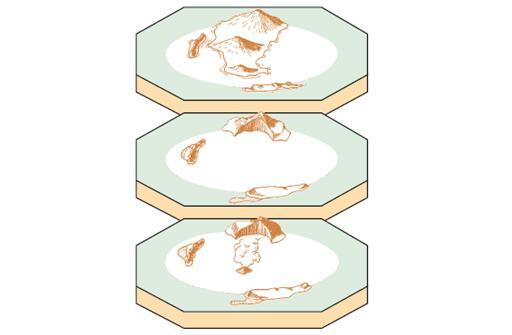
In 1997, scientists discovered evidence of an asteroid with a four kilometre (2.5 mile) diameter that landed offshore of Chile approximately two million years ago, producing a huge tsunami that swept over portions of South America and Antarctica. Scientists have concluded that the impact of a moderately large asteroid, five to six kilometres (three to four miles) in diameter, falling between the Hawaiian islands and the west coast of North America would produce a tsunami that would attack cities on the west coasts of Canada, the United States and Mexico and would cover most of the inhabited coastal areas of the Hawaiian islands. (“Tsunami Teacher”, Educational material prepared by UNESCO-IOC www.unesco.org)
It has not happened, but conceivably, a tsunami could also be generated by very large nuclear explosions.
Le Pacifique est de loin la zone où les tsunamis sont les plus actifs selon l’administration américaine chargée de l’étude des océans et de l’atmosphère (NOAA, www.noaa.gov). Mais les tsunamis ont été déclenchés dans d’autres régions marines ou océaniques comme la mer des Caraïbes, la mer Méditerranée, l’océan Indien et l’océan Atlantique. Parmi les tsunamis notables de l’Atlantique nord figure le tsunami associé au séisme qui s’est produit à Lisbonne en 1 775 et qui a entraîné la mort de plus de 60 000 personnes au Portugal, en Espagne et en Afrique du Nord. Ce séisme a déclenché un tsunami d’une hauteur de 7 mètres dans les Caraïbes.
Les Caraïbes ont été touchées par 37 tsunamis vérifiés depuis 1 498. Certains ont été déclenchés localement, d’autres par des événements éloignés, comme le séisme qui s’est produit près du Portugal. Au total, les tsunamis qui ont eu lieu dans les Caraïbes ont fait 9 500 victimes.
La région englobant la mer Méditerranée, la mer Noire et la mer Rouge est la deuxième source de tsunamis après le Pacifique. Près de 98 tsunamis y ont été observés. Les systèmes d’alerte de cette région ont pour but de contribuer à atténuer les effets des tsunamis locaux qui peuvent toucher le littoral en moins de dix minutes. Le tsunami qui est peut-être le plus célèbre, bien qu’il n’ait pas été vérifié, concerne la disparition de l’île de Santorini en 1 400 avant Jésus-Christ. Il aurait causé la mort de 100 000 personnes.
The devastating mega thrust earthquake (Indonesia/ Nicobar/ Andaman/ Sumatra Earthquake) of December 26, 2004, occurred on Sunday, December 26, 2004 at 00:58:53 GMT (7:58:53 AM local time at epicenter) with Mw=9.0 NEIC Epicenter Latitude 3.32 North, Longitude 95.85 East (USGS) or 3.09N, 94.26E southwest Banda Aceh in Northern Sumatra (Borrero, 2005). The earthquake has also triggered giant tsunami and the tsunami waves that propagated throughout the Indian Ocean and have caused extreme inundation and extensive damage, loss of property and life along the coasts of 12 surrounding counties in the Indian Ocean. The loss of lives has also been extended to the people from totally 27 countries from other parts of the world. (www.yalciner.metu.edu.tr/malaysia).

Les destructions causées par les tsunamis découlent principalement de l’impact des vagues, des inondations et de l’érosion des fondations des bâtiments, des ponts et des routes. Les dégâts sont amplifiés par les débris flottants, les bateaux et les voitures qui s’écrasent sur les bâtiments. Des courants violents, parfois associés aux tsunamis, renforcent le pouvoir de destruction en emportant les allingues, les péniches et les bateaux au mouillage. D’autres dégâts sont observés, notamment des incendies liés aux fuites de carburant ainsi que la pollution causée par les eaux usées et les produits chimiques. Ces dégâts entraînent des pertes nombreuses : humaines, socio-économiques, environnementales, culturelles et patrimoniales.
| Country | Dead | Missing |
|---|---|---|
| Indonesia | 125,598 | 94,574 |
| Thailand | 5,395 | 3,001 |
| Sri Lanka | 30,957 | 5,637 |
| India | 10,749 | 5,640 |
| Myanmar | 61 | – |
| Maldives | 82 | 26 |
| Malaysia | 68 | – |
| Somalia | 298 | – |
| Tanzania | 10 | – |
| Bangladesh | 2 | – |
| Kenya | 1 | – |
| TOTAL | 173,221 | 108,878 |
There are three factors of destructions from tsunamis: inundation, wave impact on structures, and erosion. Agricultural areas are fully flooded and destroyed beyond recovery for many years to come. Strong, tsunami-induced currents lead to the erosion of foundations and the collapse of bridges and seawalls, infrastructures. Flotation and drag forces move houses and overturn railroad cars. Considerable damage is caused by the resultant floating debris, including boats and cars that become dangerous projectiles that may crash into buildings, break power lines, and may start fires. Fires from damaged ships in ports or from ruptured coastal oil storage tanks and refinery facilities can cause damage greater than that inflicted directly by the tsunami. Of increasing concern is the potential effect of tsunami draw down, when receding waters uncover cooling water intakes of nuclear power plants. For 2004 Indian Ocean Tsunami total destruction figures are presented below:
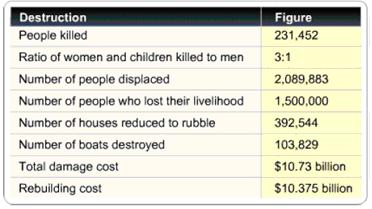
Tsunami impacts on the environment in many ways, from the death of marine life to the destruction of livestock, plant life and the impact on geological features as well as damage to mangroves, coral reefs and vegetation. Of great concern are damage to marine habitats and the impacts on coastal towns that are intertwined with fragile marine systems.
Tsunami-induced environmental problems include:
- Ground water contamination.
- Damage to coral reefs, sea grass beds and mangrove ecosystems. o Salinisation of soils and damage to vegetation and crops.
- Tsunami-generated waste and debris. o Impacts on sewage collection and treatment systems.
- Damage to protected areas. o Coastline erosion and inundation.
- Changes in river hydrology.
- Loss of livelihoods based on natural resources or ecosystem services.
Archaeological sites, historical ruins, naturally beautiful places are lost under the impact of tsunami forces and due to inundation.
Oui, bien que ces catastrophes naturelles ne puissent pas être empêchées, leurs conséquences, comme les pertes de vies humaines ou la destruction de biens, peuvent être limitées par une planification appropriée.
Pour bien planifier un risque de tsunami, il faut bien comprendre non seulement la nature physique du phénomène et de sa manifestation dans chaque localité géographique mais aussi les facteurs physiques, sociaux et culturels de cette localité. Certaines régions sont plus vulnérables aux tsunamis que d’autres. Comme la fréquence des tsunamis dans l’océan Pacifique est élevée, la gestion des risques doit être axée en grande partie sur cette région du monde. Quel que soit son éloignement, la probabilité d’un tsunami doit être prise en compte dans les plans d’aménagement des zones littorales et d’utilisation des terres.
Bien qu’un certain degré de risque soit acceptable, les organismes d’État doivent prévoir de nouveaux schémas d’aménagement et de croissance démographique dans des régions plus sûres et moins sujettes au risque. Ces organismes doivent élaborer des réglementations concernant l’usage des terres d’une région littorale en tenant compte du risque de tsunami, notamment si cette région a déjà subi des dégâts dus à ce cataclysme dans le passé. Par ailleurs, la destruction de la végétation naturelle (mangroves par exemple), qui sert de barrière naturelle contre les tsunamis, devrait être évitée. La construction de bâtiments élevés le long des zones à risque augmente le risque de destruction.
Les systèmes d’alerte rapide aux tsunamis détectent les séismes potentiellement dangereux et peuvent avertir rapidement les pays qui pourraient être touchés. La coordination de ces systèmes d’alerte mondiale est assurée par la Commission océanographique intergouvernementale de l’UNESCO (IOC, http://www.ioc-tsunami.org) avec le concours du Centre d’information international sur les tsunamis. Tirant parti de son expérience dans le Pacifique, l’IOC contribue actuellement à établir des capacités d’alerte aux tsunamis dans l’océan Indien, les Caraïbes, l’Atlantique et la Méditerranée.
Non, car les causes qui sont à l’origine d’un tsunami sont, pour l’essentiel, des processus naturels imprévisibles à ce jour, comme les tremblements de terre, les glissements de terrain et les éruptions volcaniques. On peut imaginer également que des vagues de tsunami pourraient être déclenchées par de très grosses explosions nucléaires, ce qui ne s’est pas produit à ce jour.
Compte tenu de notre incapacité actuelle à prévoir des tremblements de terre et des glissements de terrain (voir aussi les modules tremblements de terre et glissement de terrain) et les capacités de prévision très limitées des éruptions volcaniques, il est à peu près impossible de prévoir des tsunamis à l’heure actuelle.
Cependant, en examinant les tsunamis qui se sont produits dans le passé, les chercheurs peuvent prévoir avec une certaine probabilité les endroits où ils peuvent se déclencher et les zones qu’ils peuvent atteindre. On peut déduire les zones d’impact potentiel en se fondant sur les zones actives du point de vue géologique, qui présentent des risques d’éruption volcanique et de tremblement de terre. Un tremblement de terre, une éruption volcanique ou des glissements de terrain ne déclenchent pas nécessairement des tsunamis. Les mesures de la hauteur des tsunamis qui se sont déjà produits sont aussi utiles pour prédire l’impact des tsunamis futurs ainsi que des limites des inondations dans certaines zones littorales peuplées.
Très peu de choses peuvent être faites pour empêcher des catastrophes naturelles comme les inondations, les sécheresses, les ouragans, les éruptions volcaniques et les tsunamis. Mais l’humanité, dont les capacités d’adaptation sont grandes, a appris à vivre avec ces dangers.
La planification des mesures de prévention et de protection est un facteur important pour limiter les pertes dues au danger naturel. Les mesures actuelles de protection consistent à utiliser des systèmes d’alerte rapide aux tsunamis fondés sur une instrumentation perfectionnée pour la collecte des données et les émissions d’alerte. Les pays comme le Japon, la Fédération de Russie, le Canada et les États-Unis ont élaboré des systèmes d’alerte perfectionnés et accepté la responsabilité de partager des informations d’alerte avec d’autres pays du Pacifique.
En 1965, la Commission océanographique intergouvernementale (UNESCO/COI) a accepté la proposition des Etats-Unis d’agrandir le Centre des tsunamis déjà existant de Honolulu et d’en faire le Centre d’alerte aux tsunamis dans le Pacifique (PTWC, http://ptwc.weather.gov/). Elle a également créé un Groupe international de coordination (ICG/ITSU), rebaptisé par la suite Groupe intergouvernemental de coordination du Système d’alerte aux tsunamis et de mitigation dans le Pacifique (ICG/PTWS), ainsi que le Centre international d’information sur les tsunamis (ITIC, http://itic.ioc-unesco.org/) pour suivre les activités du Système international d’alerte aux tsunamis dans le Pacifique (ITWS). Ce dispositif a facilité la collaboration au niveau international et parmi de nombreux membres de la région du Pacifique. L’ICG/PTWS organise régulièrement des réunions pour évaluer les progrès et les activités réalisés par ses services.
Avec 46 Etats membres de l’océan Pacifique et de ses mers bordières (au 1er mai 2018), la zone de responsabilité du PTWS comprend l’océan Pacifique, les régions de l’océan Austral du Pacifique et toutes ses mers bordières, dont la mer des Philippines, la mer de Chine orientale, la mer Jaune, la mer d’Okhotsk, la mer de Béring, la mer de Chine méridionale, le mer de Java, la mer d’Arafura, la mer de Mindanao, la mer de Sulu, la mer des Célèbes, la mer de Bismarck, la mer des Salomon, la mer de Corail et la mer de Tasman.
Des Systèmes d’alerte aux tsunamis similaires existent également pour l’océan Indien (IOTWS) et l’Atlantique du Nord-Est, la Méditerranée et les mers adjacentes (ICG/NEAMTWS).
L’évaluation du risque, qui est une des pierres angulaires de l’atténuation des effets des tsunamis, consiste à recenser et à cartographier les zones littorales vulnérables et à comprendre le risque potentiel qui menace les personnes qui y vivent. Elle joue un rôle important dans les plans d’atténuation des effets de ces cataclysmes.
Importance de l’information et de l’éducation
On a pu se rendre compte de la valeur capitale de l’information pendant le tsunami de l’océan Indien. La plupart des victimes n’ont reçu aucune alerte, mais des milliers de vies humaines ont été sauvées lorsque les connaissances sur les tsunamis existaient et ont été utilisées.
Les experts ont déclaré que, pour être efficaces, les systèmes d’alerte aux tsunamis devaient être étayés par des campagnes de sensibilisation et des plans d’intervention en cas de situation d’urgence. Les alertes n’ont pas d’utilité si les populations ne savent pas comment y répondre. Les délais après une alerte étant courts – dans l’hypothèse où une alerte a été émise –, l’information des populations est donc cruciale, car elle leur permet de réagir immédiatement.
La valeur des connaissances locales a été illustrée par les habitants de l’île de Simeulue, qui n’a perdu que sept de ses 78 000 habitants alors que le tsunami de 2004 les a frappés huit minutes seulement après le tremblement de terre. Les populations d’autres zones côtières proches ont été décimées. Les habitants de l’île de Sumeulue sont restés en vie grâce à la tradition orale et aux enseignements tirés d’un tsunami qui s’est produit en 1907. Forts de cet acquis, ils ont su exactement ce qu’ils avaient à faire lorsque le tsunami a frappé. Ils avaient même forgé le mot « smong » pour désigner le tsunami de 1907.
A tsunami mitigation plan needs to:
- Quickly confirm potentially destructive tsunamis and reduce false alarms.
- Address local tsunami mitigation and the needs of coastal residents.
- Improve coordination and exchange of information to better utilize existing resources.
- Sustain support at state and local level for long-term tsunami hazard.
- Improve the awareness and preparedness of communities for tsunamis:
- Raise the awareness of affected populations.
- Supply tsunami evacuation maps.
- Improve tsunami warning systems.
- Incorporate tsunami planning into state and federal all-hazards mitigation programmes.
Civil defence authorities in each country can initiate public education programme consisting of seminars and workshops for responsible government officials, can publish informational booklets on the hazards of tsunami, and can co-ordinate with the communications media on the announcement of tsunami information. Other government agencies can take action also to mitigate future losses from tsunami. For example, government agencies can develop sound coastal management policies, which include zoning and planning for tsunami-prone coastal areas.
Internally, government agencies can streamline and co-ordinate their operating procedures and communications so they can perform efficiently when the tsunami threat arises. Procedures related to tsunami warnings should be reviewed frequently to define and determine better respective responsibilities between the different government agencies at all levels.
Scientific organizations can undertake research and engineering studies in developing evacuation zones or engineering guidelines for building coastal structures. Audio-visual materials can be prepared for educating children in schools and the public in general. Brochures and pamphlets can be printed describing the tsunami warning system and what the public can do in time of tsunami warning.
The natural environment can provide protection against tsunamis, and environmental destruction to make way for development can raise the tsunami risk of coastal communities. Tropical coastal ecosystems have sophisticated natural insurance mechanisms to help them survive the storm waves of typhoons and tsunamis such as coral reefs being equivalent of natural breakwaters causing waves to break offshore and allowing them to dissipate most of their destructive energy before reaching the shore.
Mangrove forests also act as natural shock absorbers, “soaking up destructive wave energy and buffering against erosion”. Systems of marshes, tidal inlets and mangrove channels also help limit the extent of inundation by floodwaters and enable flood waters to drain quickly.
Places that had healthy coral reefs and intact mangroves were far less badly hit than places where the reefs had been damaged and the mangroves ripped out and replaced by beachfront hotels and prawn farms during 2004 Tsunami.
However, there has been widespread destruction of natural coastal habitats to make way for urban development, population growth, industry, aquaculture, agriculture and tourism.
The World Wildlife Fund (WWF, http://www.worldwildlife.org) has recommended that tsunami mitigation strategies take into account:
- Rehabilitation and restoration of degraded coastal ecosystems that help protect from storm waves, especially coastal marshes and forests, mangroves and coral reefs.
- Adoption of integrated coastal zone management, including zoning and mandatory coastal setback. For example, hotels should not be built within a safety zone from the high tide mark.
- Strict enforcement of land and coastal-use planning and policies, including natural disaster risk assessments.
- Implementation of incentives to ensure that sensitive facilities are built away from high risk areas.
- Risk assessment that helps reduce the vulnerability of coastal development.
Il faut davantage sensibiliser les populations à la menace potentielle d’un tsunami par un programme d’éducation public comprenant des séminaires et des ateliers pour les responsables gouvernementaux, des brochures d’information sur les risques liés aux tsunamis et sur ce qui doit être fait lorsqu’un tsunami se produit.
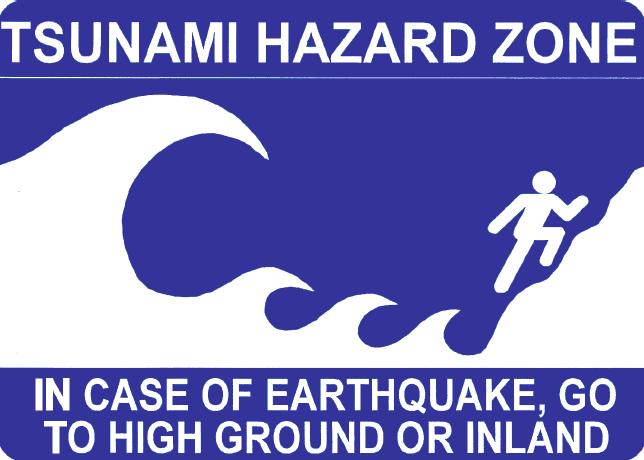
- A strong earthquake felt in a low-lying coastal area is a natural warning of possible, immediate danger. Keep calm and quickly move to higher ground away from the coast.
- Tsunamis can occur at any time, day or night. They can travel up rivers and streams that lead to the ocean.
- A tsunami is not a single wave, but a series of waves. Stay out of danger until an « ALL CLEAR » is issued by a competent authority.
- Approaching tsunamis are sometimes heralded by noticeable rise or fall of coastal waters. This is nature’s tsunami warning and should be heeded.
- A small tsunami at one beach can be a giant a few miles away. Do not let modest size of one make you lose respect for all.
- Sooner or later, tsunamis visit every coastline around the ocean.
- All tsunamis, like hurricanes, are potentially dangerous even though they may not damage every coastline they strike. • Never go down to the beach to watch for a tsunami! • WHEN YOU CAN SEE THE WAVE YOU ARE TOO CLOSE TO ESCAPE.
- Tsunamis can move faster than a person can run!
- During a tsunami emergency, your local emergency management office, police, fire and other emergency organizations will try to save your life. Give them your fullest cooperation.
- Homes and other buildings located in low lying coastal areas are not safe. Do NOT stay in such buildings if there is a tsunami warning.
- The upper floors of high, multi-story, reinforced concrete hotels can provide refuge if there is no time to quickly move inland or to higher ground.
- Stay tuned to your local radio, marine radio, NOAA Weather Radio, or television stations during a tsunami emergency – bulletins issued through your local emergency management office and National Weather Service offices can save your life.
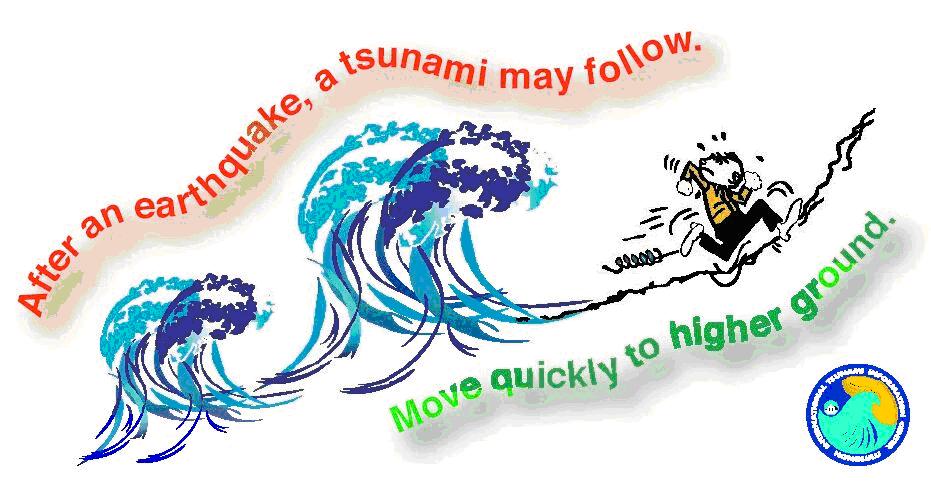
- Since tsunami wave activity is imperceptible in the open ocean, do not return to port if you are at sea and a tsunami warning has been issued for your area. Tsunamis can cause rapid changes in water level and unpredictable dangerous currents in harbours and ports.
- If there is time to move your boat or ship from port to deep water (after a tsunami warning has been issued), you should weigh the following considerations:
- Most large harbors and ports are under the control of a harbor authority and/or a vessel traffic system. Keep in contact with the authorities should a forced movement of vessel be directed.
- Smaller ports may not be under the control of a harbor authority. If you are aware there is a tsunami warning and you have time to move your vessel to deep water, then you may want to do so in an orderly manner, in consideration of other vessels.
- Damaging wave activity and unpredictable currents can affect harbors for a period of time following the initial tsunami impact on the coast. Contact the harbor authority before returning to port making sure to verify that conditions in the harbor are safe for navigation and berthing.
Une communauté vivant sur le littoral pourra subir sans dommages les effets d’un tsunami tandis qu’une autre, proche, subira des dégâts importants.
La modélisation informatique d’une inondation potentielle due à un tsunami, c’est-à-dire la pénétration horizontale des vagues dans les terres, peut mettre en évidence les zones qui seront probablement inondées pendant un tsunami (ce qui permet de produire des cartes des risques et de la vulnérabilité), ainsi que les voies que les populations peuvent emprunter en toute sécurité pour atteindre des zones de sécurité prédéterminées (ce qui permet d’élaborer des cartes d’évacuation).
Les cartes qui décrivent les zones inondables pendant un tsunami, ou zones qui peuvent être inondées par de grandes vagues, peuvent aider les planificateurs et les décideurs à délimiter les zones d’évacuation et les itinéraires de sécurité.
Il faut pour cela tenir compte des observations relatives aux inondations qui ont eu lieu dans le passé afin de valider les cartes des inondations fondées sur la modélisation.
One of the key tools for tsunami mitigation is the study and production of hazard maps of local coastal areas to ascertain how vulnerable they are to tsunamis – this can vary greatly along shorelines depending on the intensity of the waves, undersea features and the topographical lay of the land.
Hazard maps require knowledge of the historical tsunami record in order to estimate the probability that a tsunami will occur in the future. An integral part of emergency preparedness is understanding the tsunami hazard or threat. Since earthquakes are the most probable source, seismic hazard maps are needed to identify the potential earthquake source zones. In the case of tsunamis, this also includes trying to predict the potential height of waves.
In high-risk areas where the maximum potential source of a tsunami is known – for example if there is an active earthquake subduction zone offshore – tsunami generation, propagation and run-up can be mathematically modelled and wave heights estimated. Also, historical records of previous tsunamis charting earthquake magnitudes, and wave heights and run-up and inundation patterns, can be used to support tsunami hazard predictions.
One such study as outlined previously was performed for Istanbul, Turkey (Figure 1). Comprehensive tsunami simulations were based on 49 different scenarios considering not only active faults but also submarine landslide induced tsunamis by using OIC, a widely accepted, scientifically verified tsunami simulation code TUNAMI N2. The animations of the selected scenarios have been prepared by METU, The Department of Civil Engineering, Ocean Engineering Research Center using the tsunami simulation and visualization code NAMI DANCE, which has been developed for tsunami numerical modeling and simulations by Profs..Nobuo Shuto and Fumihiko Imamura in Tohoku University Japan. TUNAMI N2 determines the tsunami source characteristics from earthquake rupture characteristics. It computes all necessary parameters of tsunami behavior in shallow water and in the inundation zone allowing for a better understanding of the effect of tsunamis according to bathymetric and topographical conditions. For further information, http://yalciner.ce.metu.edu.tr/marmara/index_eng.htm
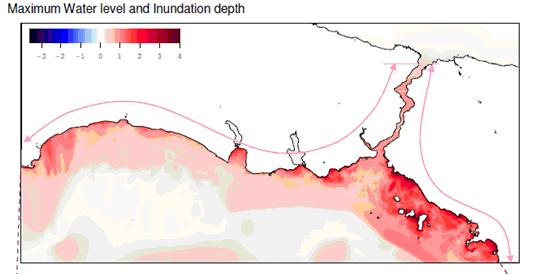
Tectonically induced tsunamis occur in Europe mainly in the Mediterranean and the Black Sea. There are several geological and historical records of tsunamis (see above). The most endangered zones lie in close vicinity to the main volcanoes or along seismically active zones. Tsunamis caused by (submarine) landslides have mainly occurred in Norway, but also in some other areas in Europe (Figure 1). Often it is difficult to distinguish if an earthquake caused a tsunami or if an earthquake triggered a (submarine) landslide that then caused a tsunami. In general it can be concluded that tsunamis are possible along all shorelines that lie in tectonically active zones and/or in areas where (submarine) landslides are possible. Even though no devastating tsunamis have occurred in Europe in the last 100 years, the potential hazard is still high. (http://www.gsf.fi/projects/espon/Tsunamis.htm)
